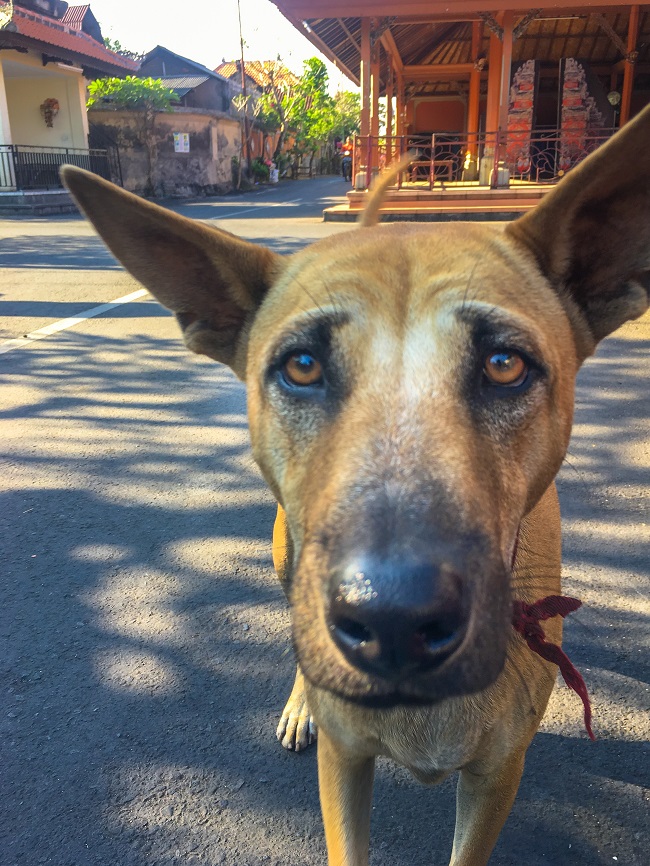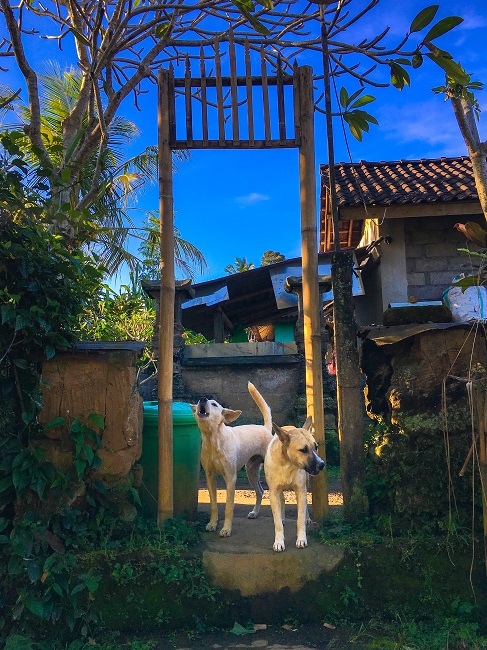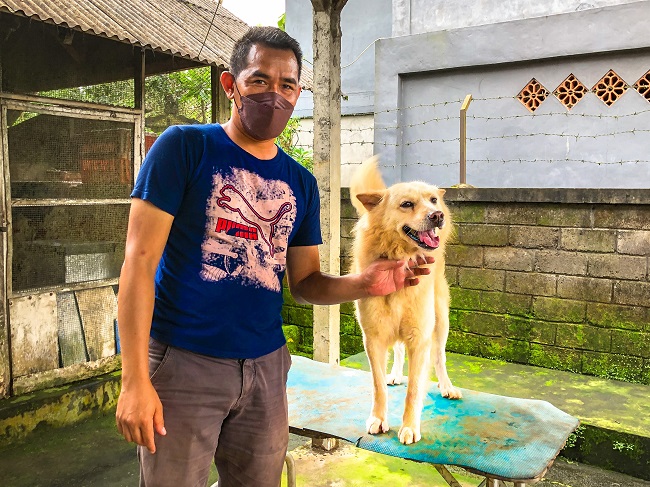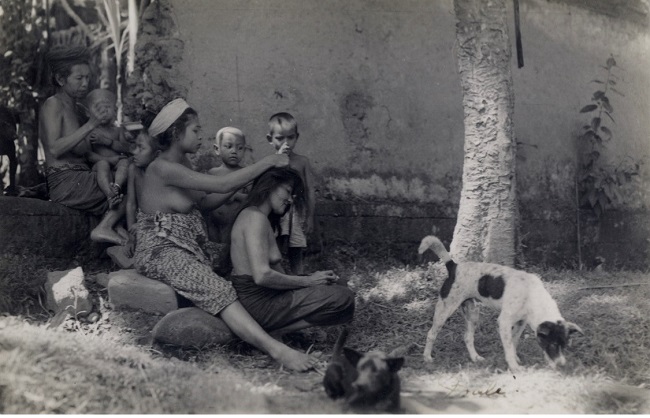The lives of Bali’s unique population of dogs have also been significantly impacted by the pandemic
Sue Useem
Mingling among the evening joggers were large groups of some of the most distinct members of traditional Balinese life. Some were old and saggy and some young and bounding full of life. The Bali Heritage Dogs (BHD) were wondering what exactly had changed for the humans. Why did they suddenly had so much free time to wander the streets?
In late February 2020, in the days surrounding the celebration of the Kuningan ceremony, the roads in Tarukan village, near Ubud, were packed. Each day hundreds of thousands of Hindu Balinese came to bid farewell to their ancestors at nearby Pura Taman Pule. But it was not only the mayhem of traffic that such an event usually brings, but rather also the sheer number of people simply coming out onto the streets to exercise.
The air smelled of wet cement and fried cooking oil, while the sounds of noisy adapted exhaust pipes rumbled the air. In addition to those making offerings at the temple were others simply enjoying a sunset outing. Flocks of teenagers on pedal bikes, middle-aged Balinese power-walking, barefoot farmers, recently unemployed cruise ship employees, migrant workers from Banyuwangi, semi-stranded tourists, and Japanese expats. An ambient uncertainty hung over the moment with half-finished ogoh-ogoh or ceremonial effigies -lying underneath blue tarps. The sudden end of the over-tourism era had arrived.

Within weeks, the seriousness of the situation was culturally transmitted, as news went viral that a sacred drum tower had sounded itself at Puri Klungkung, traditionally warning of a calamity. The roads and market in Tarukan village had always been an area where unwanted dogs were dumped, but as the economy contracted the numbers suddenly increased. What would this mean for the dogs of Bali?
BHD
The multi-coloured Bali Heritage Dog would be classified as a ‘mixed’ breed by veterinarians. Their diverse and varied appearances of different patterns, fur, and sizes, signals an old and complex DNA, link them as direct descendants of the Asian grey wolf and Australia’s Dingo their closest genetic relative. Millenia of cultural and biological evolution via mutualism have created two distinct breeds of dogs perfectly adapted to the island and its people, the lowland shorthaired BHD and the highland longhaired Kintamani (AKB), which originated about 600 years ago in Sukawana village in the Mount Batur caldera and is considered to be a mix between a BHD and a Chow-Chow.
The Bali island human-animal interaction involves many species, but none are as close as that between the Balinese and BHDs. Neither fully domesticated nor wild, both BHD and AKB are smart, clever, wildly independent dogs with strong memories and are uniquely not afraid of heights. Many are members of the banjar, a traditional Balinese village, and are expected to have roles as working members of a family compound. They are primarily a guard dog but also a rat, lizard, snake, and trash management system as well as the neutraliser of bad spirits. Although most Balinese would not profess a deep ‘love’ or companionship with a local dog, nearly all traditional Balinese compounds will have at least one, with a strong preference for male dogs as they do not produce the trouble of offspring.
Complex breed specifications within Bali culture were established in a Balinese scripture called Lontar Carcan Asu , it’s date of creation unknown, which categorizes BHD by their tails, colouring, and various measurements into 31 different groups. A family looking for the ‘right’ puppy personality can still visit a Hindu priest for the character prediction measurement ritual called the Guna Jaya Kaya Paksa that is passed down orally. The role of a Yudhistira’s beloved dog in the Mahabharata continues to give a pan-Hindu spiritual significance to the dog.
This mutualism relationship is far from harmonious. Pressing social issues in Bali impact both humans and the dogs alike - a massive increase in traffic and congestion, over population, the introduction of rabies onto the island in 2008, the pervasive dog meat trade, mass culling and poisonings, and until 2020, gaggles of foreign tourists appalled at the state of the dogs in tourist areas complaining to their hotel managers.
Welfare and wellbeing
In the past two decades menageries of local and foreign NGOs, often funded by these appalled tourists and expats, through a variety of cultural beliefs, have set out to help the dogs somewhere on the scale between animal welfare and animal rights. Western writers have been commenting on the state of the dogs since the colonial era. In 1937, a usually upbeat Covarruibas turns negative and disgusted remarking, ‘they reproduce unchecked and there are thousands of homeless living skeletons…such dogs were undoubtedly provided by the gods to keep Bali from perfection’. In his 1947 memoir, A House in Bali, Colin McPhee shares a story of a motivated Australian vet in colonial Denpasar who becomes a ‘little depressed’ after he thought he had cleared out villages of dogs, only to discover after a vacation to Java a whole new population had entered and were reproducing unchecked.

In 2008, in response to the rabies epidemic the government set about to reduce the number of dogs on the island through mass sterilisations or culling. NGOs claimed the BHD was at risk of becoming endangered and it would be a massive loss to the cultural heritage of Bali. As wealth steadily increased on the island in the 2010s, imported breeds were popping up in Balinese households across the island. While the BHD will angrily greet a visitor with their ears back and tail furiously wagging, collar-less and status-less in the household, a western breed like a husky or Pomeranian could be found in a cage or tied up in the back. ‘For the Balinese, a foreign bred dog is still a sign of status and wealth, and by putting it in a cage or tying it up, they are trying to show off that status’, says Agra Utari of Yayasan Seva Bhuana. ‘Whereas BHD remain just too plentiful to be of any monetary or societal value, with the exception of the bang bungkem dog’, a rarer black-snouted puppy still used for sacrifice in blessing ceremonies.
Pandemic impacts
When COVID-19 hit in early 2020, mass sterilisations across the island were cancelled for more than a year and all funds diverted, setting back nearly five years of work. With a large majority of the island out of work, the idea of spending nearly a month’s wage to sterilise a dog became impossible. Puppies and abandoned elderly and sick dogs began appearing everywhere, overwhelming rescuers and shelters who, almost two years later, continue to have the highest intake they’ve ever experienced; “Everytime I leave the house I could rescue five animals now’, says Prue Barber of Proyek Peduli. At the last government survey conducted in early 2021, there were 647,386 dogs on the island. It is now not known how many dogs there are, but it is likely they have recovered to their previous population levels, before the mass culling and sterilisations of the previous decade.
But it is not all bad news. Agra Utari of Yayasan Seva Bhuana is more hopeful; 'when the pandemic hit, the Balinese suddenly had a lot of free time which gave us the time to take stock of what was around us and become more nurturing to our animals and plants, and the uptick in a focus on health and exercise across all of Balinese society led more people to go out walking with their Bali dogs.’ Agra sees hope in the future, especially with younger generations interested in the ancient dogs and seeing them valued as ‘an intangible asset of Bali’. Prue Barber has also found that ‘more people are at home, helping to heal their own pets’ instead of abandoning them.
Up in the cloudy villages surrounding the crater near Kintamani is where you will find Zimba, a globe-trotting award winner of dog shows. His proud spokesperson is I Nengah Darsana, the owner of Surya Kennel. Here about 22 pure Kintamani pups, a recognised breed by Fédération Cynologique Internationale (but not yet by the American Kennel Club), are already all sold to buyers across Indonesia.

When the pandemic hit, Darsana’s sales went up, especially with Japanese expats, causing him to often run out of stock. Prices are not cheap, going at a minimum of 2.5 million rupiah for a black or white puppy, then going up to 4 million rupiah for a rare striped anggrek that is emerging as a color in demand. ‘I hope the Balinese will want to have Kintamani dogs themselves, and are able to appreciate them better, especially in terms of economics and genetics’, he says. The government can assist, he argues, by ‘providing counseling and understanding’ on the purity of the genetics of the Kintamani dog and their role in Balinese identity and history.
When asked if the heterogenous BHD deserves the same genetic attention as their fluffy highland cousins, Agra Utami explains, ‘I don’t think pure breed status is what they need. They need better treatment, improved health in general, a regulation that protects them as a historical value…maybe, when there are less of them, when most are sterilised, their populations heavily controlled, they could be rare gems that people can be proud of.’
This could happen through grassroots change beginning in the village coupled with a top down approach from the government says Agra Utami, with ‘animal welfare implementation at schools, a constant reminder in the banjar, improved responsible pet ownership, more clinics to provide affordable sterilisation to the community, more organisations focusing on sterilisation education, and a seamless bureaucracy to ease NGOs and the community helping each other.’
When foreign tourists do return to post-pandemic Bali, they will find the island once again awash in dogs, but with a more complex grassroots movement led by young people embracing animal welfare. With the right direction and oversight from the Bali provincial government and NGOs, the next era of Bali can begin with a greater, island-wide harmonious relationship with their unique dogs.
Sue Useem <@sueuseem> is an entrepreneur and documentary filmmaker living between Washington DC and Bali.












